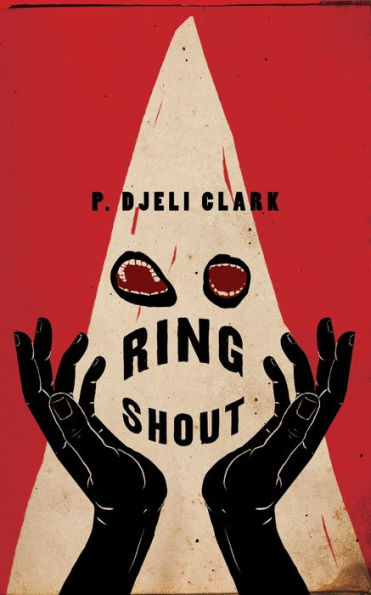Welcome back to Reading the Weird (né the Lovecraft reread), in which we get girl cooties all over weird fiction, cosmic horror, and Lovecraftiana—from its historical roots through its most recent branches.
This week, we introduce our new column format, and ruminate on what it means to be weird.
Ruthanna’s Commentary
Three-hundred posts. Six years. And an uncountable number of insightful and entertaining comments… I’m not sure what I was expecting when I originally cold-emailed Anne to pitch a collaborative blog series, but I’m pretty happy with what we got!
But over the course of those posts, “what we got” has changed. We started out as, literally, a reread of H. P. Lovecraft’s short stories. Well, almost literally—many of them were new to me, and I think a couple of the more obscure pieces may even have been new to Anne. But as we dug further into Lovecraft’s oeuvre, we started to expand our focus—first to immediate members of the “Lovecraft circle,” then to earlier and later inspirations and examples of cosmic horror and Weirdness.
As we’ve expanded, we’ve used three terms for our eldritch little subgenre more-or-less interchangeably: Lovecraftian fiction, cosmic horror, and the Weird. But the non-Euclidean venns don’t fully overlap. Lovecraftiana tends to riff off of the tropes, settings, and entities created by its namesake. Cosmic horror is all about the philosophy: the terror of deep time and deep space, in which humanity is a trivial side-note. And the Weird? That’s the biggest tent of all, and the one that keeps the bar moving. It’s about what still has the power to startle. It uses fantastic settings, creatures, language, to invite you to think differently—whether about Innsmouth or infinity. With our title change to “Reading the Weird,” we acknowledge that breadth.
But the change acknowledges more than that. Lovecraft is a center of the Weird, and inspiration to many including me and Anne, but he’s not the center. That’s part of the genre, isn’t it, admitting that the center is an illusion? Or maybe it’s a tool: a choice of telescope or microscope or spectroscope to interpret the brand new color you’ve just found. Looking at stories relative to Lovecraft is a lens—not one we want to discard, but we could also easily center the genre on Poe, Chambers, Stevens, or Blackwood, and come up with different insights. Alternatively—time also being an illusion, and the Weird having grown stranger and richer over it anyway—we could center on Jackson, King, Moreno-Garcia, or McGuire/Grant. All draw on earlier work, and all have helped reshape the conversation.
But—you are all asking, I’m sure, unless it’s just me—what about our cyclopeans? For most of the column, I’ve been the keeper of our metrics (with Anne our intrepid summarizer), and as our scope has expanded I’ve had to figure out exactly how they apply to authors who are a little less fond of amaranthine adjectives. So here’s a guide to how I’m currently thinking about them:
What’s Cyclopean: What are the quirks, absurdities, and delights of this story’s language? Is there a word of the day, or a perfect turn of phrase, or perhaps variably successful poetry? Sometimes authors just want to make sure you can picture the indescribable, and sometimes the language itself is one of the things that forces you to question your expectations.
The Degenerate Dutch: How does the story reflect real-world alienation and oppression? Does it engage with, ignore, or just embody the mundanities of human malevolence and lack of caring? Not every piece does this, or has to, but some of the most powerful weird storytelling comes at the intersection of human and inhuman horror.
Mythos Making: This, I think, is the place where the Lovecraftian lens has gotten most narrowly focused—we’ve been looking for each story’s overlap with Lovecraft’s tropes and assumptions, whether explicit shoggothim or just a familiar-looking take on suspicious small towns. So this is the one we’re changing: Weirdbuilding will note first appearances, connections and callbacks from across the subgenre, whether or not Lovecraft ever touched them.
Libronomicon: When something inexplicable happens, you’ve gotta look it up, right? Or maybe it happened because you looked something up—stop doing that! Here we catalog sources of sorcery, encyclopedias of the eldritch, and other potential volumes for the restricted section of the library.
Madness Takes Its Toll: The Weird has always had a fraught relationship with mental illness—often reflecting the history of society’s fraught relationship with it. Some stories genuinely (if dramatically) deal with the psychological impact of encountering things that couldn’t/shouldn’t exist. Others use “madness” as a prop, following a “sanity points” model of the mind. And some stories are just plain ableist, while others manage real insight.
These will continue to show up in every post for the short stories. For longreads, where they may not all apply, or may be similar for every chapter, I’ll highlight the ones that seem most relevant each week.
Lovecraft isn’t going anywhere. “Lovecraft Country,” along with the last few years of deconstructive storytelling by those he would have considered monsters, shows that his tropes are still powerful tools for examining the horrors he embraced as well as those he shrank from. But by renaming our column to include others lenses and centers, we hope to do a little to make all the weird’s shadowy corners more visible.
Anne’s Commentary
What a long weird trip it’s been! Three hundred explorations of the darker side of fantastic fiction later, and I feel we’ve just scratched the squamous epidermis of the beast. Can our unspeakably long and unnameably sharp talons sink deeper into the uncanny canon?
Hell yeah. Pass me the claw file.
Now. What is this weird we mean to continue tackling? What is weird?
To start: I am weird. People have been telling me so all my life, sometimes while slowly backing off, sometimes while welcoming me to the club. One recent example. I’ve met weekly with a group of women to discuss Intuitive Eating. At the start of the group, everyone describes one thing that made them happy that week. Most members talked about the exploits of their children or grandchildren or partners or pets—you know, wholesome human stuff. One week I waxed enthusiastic about Lilith, a super-rare blue-eyed leucistic king cobra who must indeed be Yig’s favorite daughter. Did they want to see a picture of her?
No, they did not. Snakes are weird. Venomous snakes are weirder. People who think venomous snakes are beautiful are the weirdest. Not that they said any of these things, but I could see it in their raised eyebrows and puzzled frowns. It was an expression I’d seen many times before, like when I’d admitted my favorite genre to read and write as SFF, horror, dark fantasy, or, yes, weird fiction.
Buy the Book


Ring Shout
I’m talking, of course, about the “normal” people, not people in the fandom. “Normal” people will go supernaturally dark for their entertainment, or Stephen King and Dean Koontz and Anne Rice wouldn’t be the mega-bestsellers that they are. Lovecraft and those who have preceded and followed him into more obscure and twisted realms are, well, more obscure—whether they were or are statistically more twisted than your mainstream creators, I doubt. I know I’m not twisted. Nor is Ruthanna. I think…
But if enjoying pretty much every one of the three hundred stories and films in the Lovecraft Reread makes me weird, then I’m weird, and proud of it. We have covered some amazing stuff. Stuff I never would have discovered if not for this blog. I feel blessed, or if you will, happily cursed.
But again, what is the weird? Could it be as simple and inclusive as everything that is not mainstream? I’m not thinking so. The not-mainstream includes a lot of work in which the oddness lies more in style or structure than content. So, is content the defining factor?
Let’s run with that.
The weird is not merely a matter of shoggoths or ghouls, Yith or Yuggothian, reanimators or the reanimated, Great Old Ones or Outer Gods, though these “Lovecraftian” tropes pulse with lurid brilliance in its firmament. Even so, we might define the weird via a concept beloved by our Howard and other Mythos writers: the thing that should not be. We live in a cocoon of the known. It’s more or less comfortable depending on our circumstances, but at least it harbors only people, places, creatures, objects, forces and ideas that we kind of understand and that we accept as part of our reality. They are the things that should be.
Wait, let me redefine that: They are the things that ARE. Some of them, though part of our reality, that’s just the way it is, should NOT be, in our human-centered opinion. They bother us. They afflict us. They may even kill us. Things like disease-causing viruses and bacteria and fungi. Things like mosquitoes and rabid dogs and man-eating tigers. Things like bias and injustice and hatred and all the horrors that spring from them. Things like the sheer vastness of time and space and the realization of how little we understand about all that cosmos out there, how comparatively minuscule is our own reach and span of years.
These bother, afflict, potentially destroy us. These also intrigue and fascinate us. In the first case, we can deal with our fears through metaphor—by making the troublesome thing that is but shouldn’t be into the thing that not only shouldn’t be but really isn’t, the monster, the revenant, the alien, the alternative dimension. In the second case, we can deal with our attraction to the beyond by instilling the metaphor with such glamor that the thing that really isn’t SHOULD be, so we could have that, go there, be that.
In a great weird fiction, like Lovecraft’s Dreamlands, both motivations have been at work. Fear finds ample expression in night-gaunts and moon-beasts and the avatar of incomprehensible gods which is Nyarlathotep. Attraction to the fantastic births the glories of Celephais and Thalarion, the cat-dominated homeliness of Ulthar, the thrills of adventuring in the Underworld and climbing the slopes of Hatheg-Kla and daring even the rigors of outer space—all without death or consequent insanity.
Don’t worry. Weird fiction features plenty of death and insanity for our vicarious shuddering and Monday midnight quarterbacking (I would never have gone there/done that.)
Have I figured out what is the weird yet? I know this much: The weird is everywhere in the world. We have traveled from North to South America, hopped the Atlantic to Africa, worked our way into Europe and Asia. I don’t know if we’ve made it yet to Australia, natural home of the weird! [RE: Tamsin Muir’s in New Zealand, though! Also I spot two volumes of Cthulhu: Deep Down Under to add to our anthology shelf.] Antarctica I know we’ve missed, as far as authors are concerned. Are there any Elder Things who’d like to contribute a story or two?
I also know this: Wherever there is a twist or tear in the fabric of a fictional reality, I’m ready to go there with my stalwart colleague Ruthanna.
Maybe with Carl Kolchak too, to take the photos that will prove it was all REAL.
Fellow Weirdos, please join us in reading that elusive, enticing weirdness!
Next week, we start our alternating-week longread feature with the inestimable Shirley Jackson’s The Haunting of Hill House—an old favorite of Anne’s (along with many other readers) and new to Ruthanna (entering through the front door with wide eyes). Anne will share a little historical background, and then we’ll cover Chapter 1, sections 1-2 (up through the character sketches).
Ruthanna Emrys is the author of the Innsmouth Legacy series, including Winter Tide and Deep Roots. Her short story collection, Imperfect Commentaries, is now available from Lethe Press. You can find some of her fiction, weird and otherwise, on Tor.com, most recently “The Word of Flesh and Soul.” Ruthanna is online on Twitter and Patreon, and offline in a mysterious manor house with her large, chaotic household—mostly mammalian—outside Washington DC.
Anne M. Pillsworth’s short story “The Madonna of the Abattoir” appears on Tor.com. Her young adult Mythos novel, Summoned, is available from Tor Teen along with sequel Fathomless. She lives in Edgewood, a Victorian trolley car suburb of Providence, Rhode Island, uncomfortably near Joseph Curwen’s underground laboratory.














aw, from the title I thought you were going to be doing a David Wong read-a-long. :D
I’m incredibly excited to see what’s next. :)
Congratulations on 300, and I just finished The Haunting of Hill House and found myself wishing someone would do a companion novel from Theodora’s perspective (Sarah Waters came to mind, though maybe a Theo could be a less unreliable viewpoint character than the doctor in The Little Stranger). Also, in light of the change of name here, I was reminded of Mark Fisher’s The Weird and the Eerie, which might well appeal to readers here, and maybe the writers https://repeaterbooks.com/product/the-weird-and-the-eerie/
Antarctica I know we’ve missed,
No, you got that. https://www.tor.com/2015/10/27/animal-vegetable-mineral-or-horror-from-beyond-the-stars-at-the-mountains-of-madness-part-1/
This looks like it’s going to be awesome!
If you’re at all interested in recommendations for non-Lovecraftian weird fiction, I personally find that a lot of Stephen Baxter’s work very powerfully evokes the philosophical “cosmic horror” theme of human insignificance in a vast and uncaring cosmos. I particularly recommend the short story “In the Abyss of Time”.
Sounds great! I’m looking forward to seeing this continue!
I don’t know why this just came to mind and maybe it’s a dumb idea, but maybe one really eccentric subgenre of the weird to look at some time would be the early 20th century Christian-themed esoteric dark fantasy novels of Charles Williams, maybe All Hallows Eve or Descent Into Hell, or the less celebrated and incredibly peculiar Shadows of Ecstasy. Williams has a really distinctive sensibility and while I wouldn’t really call any of his stuff horror, it’s definitely… weird, like reality is uneasily suspended over a psychological abyss, and super-Gothic things coexist with the sublime. I’d be very curious to hear your particular takes on that.
For shorter things in more of a horror vein… you haven’t done any Clive Barker in this, have you? I mean not so much his ultra-gory ones, more like the psychological horror of “Human Remains”, or “In the Hills, the Cities” that’s almost like cosmic horror made of only human elements.
Great Azathoth, Lilith is beautiful! What kind of person wouldn’t want to adore a photo of her? There are such weird people :/
I ponder upon the difference between being twisted and being able, as it were, to Do the Twist. I suppose it’s all a question of what happens when the music stops…
Love and congratulations to you. I’m glad you’re making this turn into territory stlll more fruitful.
“What still has the power to startle” is itself a phrase in the Cyclopean dialect. Evocative and perfectly specific. It reminds me of what one deep reviewer wrote about Tanith Lee’s fantasies … She writes not to inform, but to amaze.
“Weirdbuilding” is another.
You’ll be getting a ton of recommendations, I’m sure. For myself, I’d love to see your takes on some oldies:
C.M. Kornbluth, The Words of Guru
https://nyc3.digitaloceanspaces.com/sffaudio-usa/usa-pdfs/TheWordsOfGuruByC.M.KornbluthAFR5.pdf
John Collier, Evening Primrose
and then several more contemporary stories by Greg Egan: Transition Dreams,, if you care to dig it up; but conveniently,
TAP
http://www.infinityplus.co.uk/stories/tap.htm
and
The Demon’s Passage
http://eidolon.net/?story=The%20Demons%20Passage&pagetitle=The+Demon%92s+Passage§ion=fiction
As always, looking forward to your next.
I just reread ‘The Haunting of Hill House’ for the first time in many years, as there was an ebook sale on it – over now, it appears – so I’ll be joining your reread with interest!
I certainly feel that I got more out of it this time than I did whenever I first read it, probably teens or early 20s.
Also, as I should have said in the first place, congratulations on the relaunch!
I recommend author Anna Tambour as one of Australia’s contributions to the Weird.
I’m glad to see the column will still be mostly the same, and Weirdbuilding is a truly excellent term that I might end up borrowing for my personal lexicon. I look forward to reading your future explorations into the uncanny!
I wouldn’t be surprised if most of us here were considered weird. It’s a good thing.
For starters, this is a comment thread on the internet that is actively worth reading. That’s definitely not normal ;)
Lilith is gorgeous!!!!
I need to track down my copy of Haunting or if all else fails get it from the library – been too many years, and I am overdue for a re-read.
Looking forward to this series continuing! I am not always up to speed (Real Life has a nasty way of interfering with my quality reading time!!!!!) but I try to read every issue, even if I don’t comment. <3
Hi, folks.
I stumbled on the Lovecraft Reread only a few months ago, and was so late to the party (no drinks left, not even any chips) that I didn’t try to comment. But I’ve really enjoyed catching up with it.
So this new title gives me a chance to say hello, and thanks. And to definitely second the nomination of “The Words of Guru.” I read that story once, literally 40+ years ago, and just thinking of it still creeps me out.
I was introduced to Lovecraft through a Creepy (or was it Eerie?) magazine adaption of Cool Air, illustrated by the fantastic Bernie Wrightson (RIP). I found a collection of Lovecraft’s works at the public library, and appreciated the original story enough to read a few more of his tales. FYI: Theodore Sturgeon has a collection of weird in a book titled E Pluribus Unicorn, which I recommend.
My introduction to Lovecraft was in the late 1960s, when I was about 13 or 14, and the Pacifica radio station in New York had somebody read aloud “The Outsider” and “The Hound.” Warped my mind forever.
@Jonathan Burns: Thanks to that link to “The Words of Guru.” It still creeps me out. Though this time I notice that it owes a lot to Machen’s “The White People.”
Two more recommendation: Oliver Onions’ short stories, especially “The Beckoning Fair One”; and William Sloane’s brilliant 1939 novel “The Edge of Running Water.”
I am so for this. This renaming opens the project up in more ways than one, and I am deeply excited to keep following along. Thank you to Anne and Ruthanna, and all my fellow readers. There are some commenters I consistently disagree with, and I love each and every one of you for helping expand my horizons. Ad Astra, everyone! To another 300 weeks!
I’m thinking
“I don’t know much about art, but I know what I like!”
but changing it to
”I don’t know much about the Weird, but I know what I like…”
:)
I’d like to nominate a work for review in Reading the Weird: “To Walk the Night,” a 1937 short novel by William Sloane. Although there is no explicit reference to Lovecraft or to any element of the Mythos, and the work has none of the stylistic elements of pulp fiction, it is perfectly obvious that it is written in the universe of “The Shadow Out of Time.” There is even a moment when the traveler shows deep interest in some books of mathematics written in Arabic. The writing quality puts it pretty unambiguously in the top one or two percent of Mythos writings on that dimension. Likewise, the dialog is perhaps the most subtle I have encountered in the genre. And, amazingly, it’s a love story, albeit one that ends unhappily, as all true Lovecraftian horror must. The references to Lovecraft are only implied, but the references to “The Little Mermaid” were quite explicit. I cried. Not an experience that I’ve had with anything else from the Mythos tradition.
It was reprinted in a two-novel set called “The Rim of Morning.”
I’d also like 5o give a callout to David Hambling’s Harry Stubbs tetralogy, which is explicitly an attempt to bring the Mythos to South London and which is unusual in having a working-class protagonist — a former professional boxer, in fact. Personally I think these thrillers write themselves out of the Mythos by having happy endings, and the writing is more nearly average in quality. Still, the climax of book four is not the most elegantly crafted tribute to Lovecraft himself that I could have imagined only because I could not have imagined a tribute so elegant.
On the topic of “the weird”, have you by chance run into the Odd Jobs series, by Heide Goody and Iain Grant? The books are apparently the result of a secret love affair between Cthulhu and Dirk Gently, in beautiful Birmingham, England. Both H.P. Lovecraft and Douglas Adams might be horrified at their characters’ lovechild– interspersing Lovecraftian horror with English humor is unexpected, and a great deal of fun.
As someone once said: “The Universe is not only stranger than we suppose, it is stranger than we can suppose.” And presumably weirder, as well.